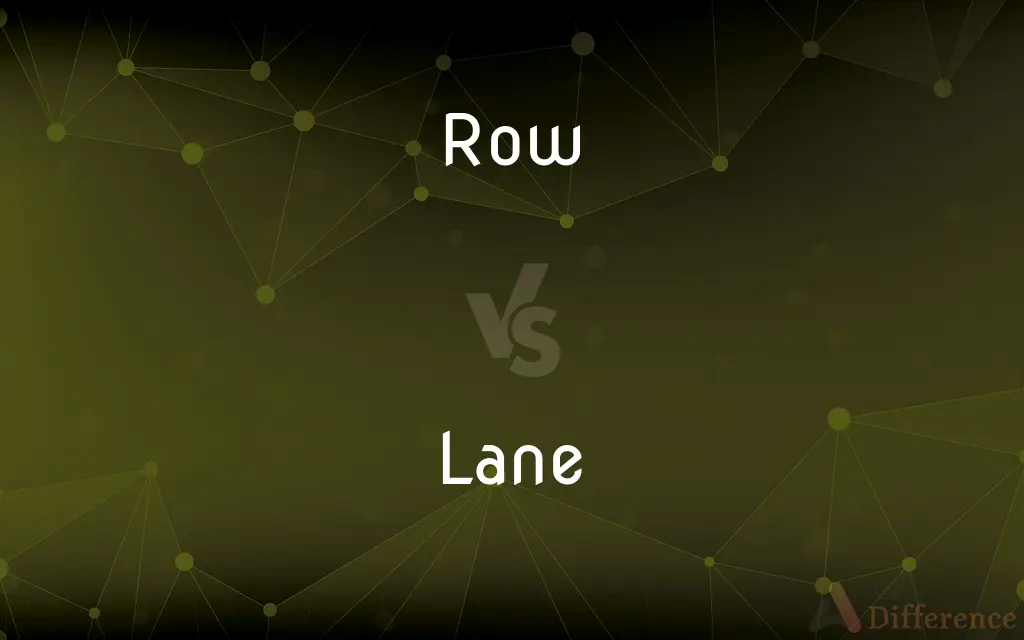Row vs. Lane — What's the Difference?
By Urooj Arif & Fiza Rafique — Updated on March 7, 2024
A row is a linear arrangement of items side by side, often in a horizontal direction, while a lane denotes a narrow path or division, especially on roads or in water, guiding movement or traffic.

Difference Between Row and Lane
Table of Contents
ADVERTISEMENT
Key Differences
A row refers to a series of objects placed directly next to each other, typically in a straight line. This arrangement can be found in various contexts, such as seating in theaters or items on a shelf. On the other hand, a lane is a subdivision of a road, track, or waterway designated for specific traffic flow, such as cars, bikes, or swimming, emphasizing direction and regulation.
Rows are commonly used in settings where organization and accessibility are key. For example, rows of seats in a cinema allow viewers to sit side by side with clear views of the screen. Whereas lanes facilitate the smooth movement of vehicles or participants, ensuring safety and order by segregating different types of traffic or speeds.
In agriculture, rows are utilized to plant crops in a manner that maximizes space and efficiency for growth and irrigation. Conversely, lanes might be found in rural areas as paths between or alongside fields, but they primarily serve navigation purposes, not cultivation.
In data representation, a row can signify a single record in a table, aligning data points horizontally. Meanwhile, a lane could metaphorically refer to channels in data processing or networking, where it represents a path for data packets or signals, focusing on the flow of information.
While rows are essential for the systematic arrangement and presentation of items or people, emphasizing accessibility and order, lanes are crucial for guiding movement and enhancing safety and efficiency in transportation or activities, highlighting the dynamic aspect of navigation and regulation.
ADVERTISEMENT
Comparison Chart
Definition
A linear arrangement of objects or people side by side.
A narrow path or division, designated for specific movement or traffic.
Context
Used in theaters, agriculture, data tables.
Used in roads, swimming pools, tracks.
Purpose
Organization, accessibility, and systematic arrangement.
Safety, regulation, and direction of movement or traffic.
Example
Rows of seats in a cinema.
Lanes in a swimming pool or highway.
Spatial Orientation
Typically horizontal but can be vertical.
Predominantly longitudinal, following the path or road.
Compare with Definitions
Row
A line of people or things arranged side by side.
Rows of corn stretched as far as the eye could see.
Lane
A narrow division in a swimming pool.
She swam laps in the fastest lane.
Row
A quarrel or argument.
They had a row over who would pay the bill.
Lane
A narrow road or path.
The country lane was bordered by wildflowers.
Row
A horizontal line of data in a spreadsheet.
Each row in the spreadsheet represents a different transaction.
Lane
A path designated for a specific purpose.
The bike lane keeps cyclists safe from vehicular traffic.
Row
Continuous line of seats.
We found our seats in the front row of the theater.
Lane
A division of a road marked by lines for regulating traffic.
The left lane is for passing only.
Row
A series of objects placed side by side.
The students sat in a row during the assembly.
Lane
In road transport, a lane is part of a carriageway that is designated to be used by a single line of vehicles to control and guide drivers and reduce traffic conflicts. Most public roads (highways) have at least two lanes, one for traffic in each direction, separated by lane markings.
Row
A series of objects placed next to each other, usually in a straight line.
Lane
A track for racing.
The runner in lane four won the race.
Row
A succession without a break or gap in time
Won the title for three years in a row.
Lane
A narrow road, especially in a rural area
She drove along the winding lane
Row
A line of adjacent seats, as in a theater, auditorium, or classroom.
Lane
A division of a road marked off with painted lines and intended to separate single lines of traffic according to speed or direction
The car moved into the outside lane
A bus lane
Row
A continuous line of buildings along a street.
Lane
A narrow country road.
Row
The act or an instance of rowing.
Lane
A narrow way or passage between walls, hedges, or fences.
Row
A shift at the oars of a boat.
Lane
A prescribed course for ships or aircraft.
Row
A trip or an excursion in a rowboat.
Lane
A strip delineated on a street or highway to accommodate a single line of vehicles
A breakdown lane.
An express lane.
Row
A noisy or quarrel or disturbance.
Lane
(Sports) One of a set of parallel courses marking the bounds for contestants in a race, especially in swimming or track.
Row
A loud noise.
Lane
(Sports) A wood-surfaced passageway or alley along which a bowling ball is rolled.
Row
To place in a row.
Lane
(Sports) An unmarked lengthwise area of a playing field or ice rink viewed as the main playing area for a particular position, such as a wing in soccer.
Row
To use an oar or pair of oars in propelling a boat, typically by facing the stern and pulling the oar handle toward oneself, using an oarlock as a fulcrum to push the blade backward through the water repeatedly.
Lane
(Basketball) The rectangular area marked on a court from the end line to the foul line.
Row
To propel (a boat) with oars.
Lane
(used in street names) A road, street, or similar thoroughfare.
Penny Lane
Row
To carry in or on a boat propelled by oars.
Lane
A narrow passageway between fences, walls, hedges or trees.
There's a shortcut to the shops through this leafy lane.
Row
To use (a specified number of oars or people deploying them).
Lane
A narrow road, as in the country.
Row
To propel or convey in a manner resembling rowing of a boat.
Lane
A lengthwise division of roadway intended for a single line of vehicles.
Drivers should overtake in the outside lane
We were held up by a truck in the middle lane of the freeway.
The exit lane
Row
To pull (an oar) as part of a racing crew.
Lane
A similar division of a racetrack to keep runners apart.
There are eight lanes on an Olympic running track.
Row
To race against by rowing.
Lane
Any of a number of parallel tracks or passages.
The checkout lanes in a supermarket
A swimming lane
Row
To take part in a noisy quarrel or disturbance.
Lane
A course designated for ships or aircrafts.
Shipping lane
Row
A line of objects, often regularly spaced, such as seats in a theatre, vegetable plants in a garden etc.
Lane
(bowling) An elongated wooden strip of floor along which a bowling ball is rolled.
We booked a couple of lanes at the bowling alley.
Row
A horizontal line of entries in a table, etc., going from left to right, as opposed to a column going from top to bottom.
Lane
(card games) An empty space in the tableau, formed by the removal of an entire row of cards.
Row
An act or instance of rowing.
I went for an early-morning row.
Lane
(computing) Any of the parallel slots in which values can be stored in a SIMD architecture.
Row
(weightlifting) An exercise performed with a pulling motion of the arms towards the back.
Lane
(video games) In MOBA (multiplayer online battle arena) games, a particular path on the map that may be traversed by enemy characters.
Row
A noisy argument.
There was a row among the oarsmen about how to row.
Lane
(horse racing) The home stretch.
And it's Uncle Mo in front by two as they come to the top of the lane.
Row
A continual loud noise.
Who's making that row?
Lane
Alone.
Row
To propel (a boat or other craft) over water using oars.
Lane
A passageway between fences or hedges which is not traveled as a highroad; an alley between buildings; a narrow way among trees, rocks, and other natural obstructions; hence, in a general sense, a narrow passageway; as, a lane between lines of men, or through a field of ice.
It is become a turn-again lane unto them which they can not go through.
Row
(transitive) To transport in a boat propelled with oars.
To row the captain ashore in his barge
Lane
A narrow way or road
Row
(intransitive) To be moved by oars.
The boat rows easily.
Lane
A well-defined track or path; for e.g. swimmers or lines of traffic
Row
(intransitive) To argue noisily.
Row
Rough; stern; angry.
Row
A noisy, turbulent quarrel or disturbance; a brawl.
Row
A series of persons or things arranged in a continued line; a line; a rank; a file; as, a row of trees; a row of houses or columns.
And there were windows in three rows.
The bright seraphim in burning row.
Row
The act of rowing; excursion in a rowboat.
Row
To propel with oars, as a boat or vessel, along the surface of water; as, to row a boat.
Row
To transport in a boat propelled with oars; as, to row the captain ashore in his barge.
Row
To use the oar; as, to row well.
Row
To be moved by oars; as, the boat rows easily.
Row
An arrangement of objects or people side by side in a line;
A row of chairs
Row
An angry dispute;
They had a quarrel
They had words
Row
A long continuous strip (usually running horizontally);
A mackerel sky filled with rows of clouds
Rows of barbed wire protected the trenches
Row
(construction) a layer of masonry;
A course of bricks
Row
A linear array of numbers side by side
Row
A continuous chronological succession without an interruption;
They won the championship three years in a row
Row
The act of rowing as a sport
Row
Propel with oars;
Row the boat across the lake
Common Curiosities
Are lanes always on roads?
No, lanes can also be in swimming pools, tracks, and other areas requiring regulated movement.
Can the concept of a row apply to data?
Yes, in data tables, a row represents a horizontal line of data points.
What is the main difference between a row and a lane?
A row is a linear arrangement of objects or people side by side, while a lane is a designated path for traffic or movement.
Is a lane always physically marked?
Not always, but lanes are often marked for clarity and safety, especially on roads and in competitive tracks.
How do rows improve organization?
Rows allow for systematic arrangement, making items or people easier to count, access, and manage.
Can a row exist in digital formats?
Yes, rows are used in digital formats like spreadsheets or databases to organize data.
Can rows be vertical?
Yes, rows can be arranged vertically, although they are more commonly horizontal.
Can lanes change direction?
Yes, lanes can be designated for specific directions, and their directions can change based on traffic needs.
How do rows and lanes differ in purpose in agriculture?
Rows are used for planting and organizing crops, while lanes might serve as paths for movement but are not used for planting.
Why are lanes important in transportation?
Lanes regulate traffic flow, enhance safety, and ensure orderly movement.
What role do lanes play in competitive sports?
Lanes ensure fairness by providing equal conditions for all competitors, such as in swimming or track races.
How do rows assist in inventory management?
By organizing items in rows, inventory can be more easily counted, accessed, and managed.
Do rows have to be straight?
Rows are typically straight for organization and uniformity, but they can vary based on context.
Can the definition of a lane extend beyond physical spaces?
Metaphorically, yes. In networking or data processing, "lane" can refer to channels for data flow.
What makes a lane different from a regular path?
A lane is specifically designated for a certain type of use or traffic, unlike a general path.
Share Your Discovery

Previous Comparison
Integrate vs. Merge
Next Comparison
Introspection vs. ReflectionAuthor Spotlight
Written by
Urooj ArifUrooj is a skilled content writer at Ask Difference, known for her exceptional ability to simplify complex topics into engaging and informative content. With a passion for research and a flair for clear, concise writing, she consistently delivers articles that resonate with our diverse audience.
Co-written by
Fiza RafiqueFiza Rafique is a skilled content writer at AskDifference.com, where she meticulously refines and enhances written pieces. Drawing from her vast editorial expertise, Fiza ensures clarity, accuracy, and precision in every article. Passionate about language, she continually seeks to elevate the quality of content for readers worldwide.














































